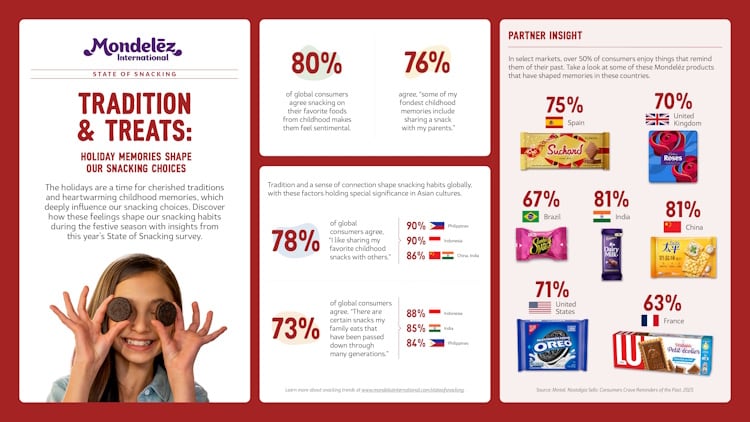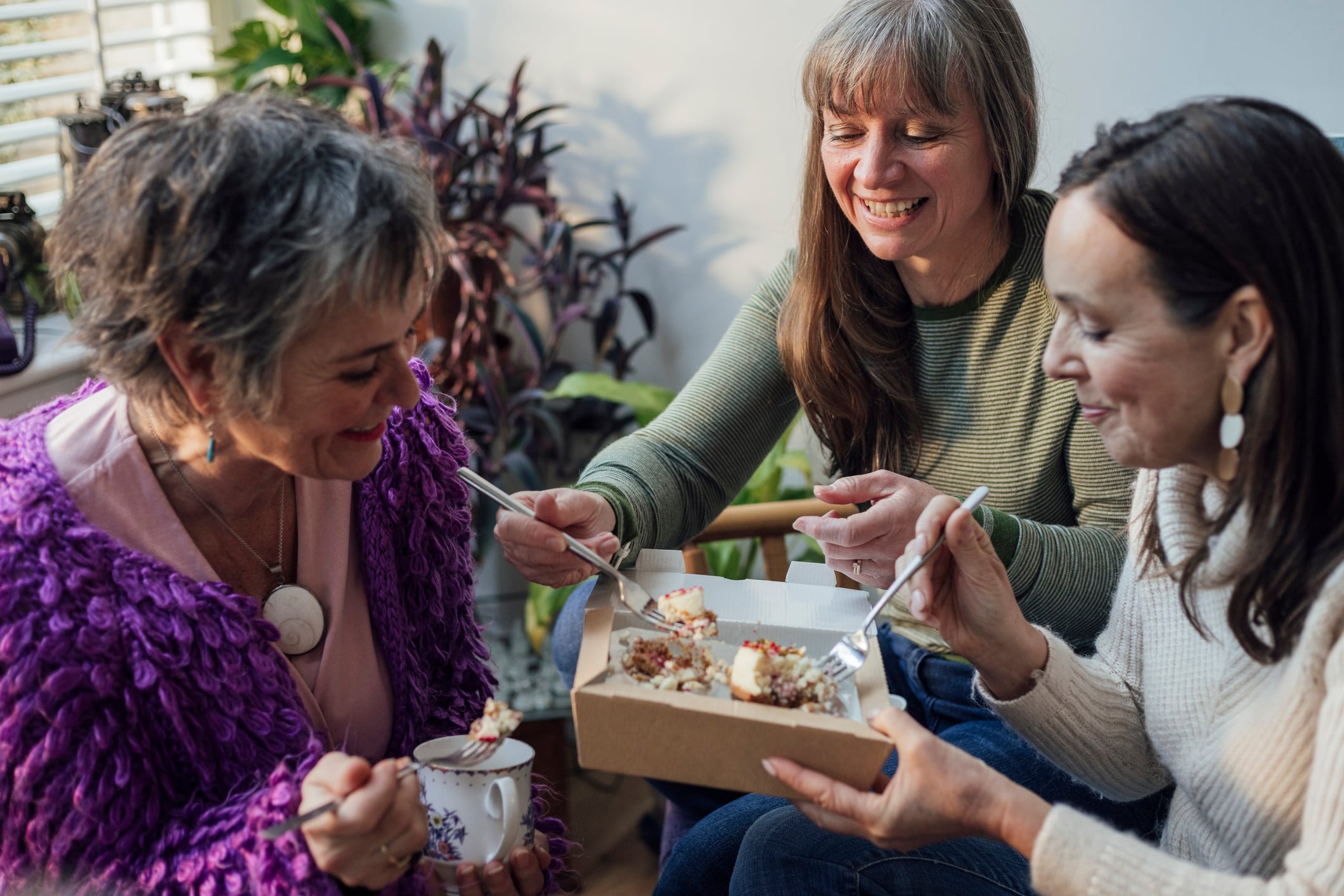Key takeaways:
- Nostalgia has become a major growth driver, with consumers increasingly seeking snacks that reconnect them to childhood memories and family traditions.
- Emotional value now rivals price and function, as shoppers look for authenticity, comfort and trust in their favorite snack brands.
- Modern packaging and innovation keep classics relevant, helping brands refresh heritage products for new generations without losing their emotional pull.
There’s something about the holidays that makes people crave the past. Maybe it’s the tin of biscuits your grandmother used to buy or the crinkle of a candy wrapper that always meant Christmas was near. According to Mondelēz International’s latest State of Snacking report, those small traditions matter more than we realize.
The sixth edition of the annual survey – run with The Harris Poll – looks at snacking habits across 12 countries. Its findings confirm what many in the industry have long suspected: we don’t just eat snacks, we build memories around them. 80% of people say their favorite childhood snacks make them feel nostalgic, and 76% remember sharing snacks with their parents as one of their fondest memories. That’s not marketing fluff – it’s generational muscle memory.
From moon cakes to milk chocolate, those traditions have become edible heirlooms. In fact, 73% of global consumers say certain snacks have been part of their family for generations. That connection runs especially deep in Asia, where 88% of Indonesians, 85% of Indians and 84% of Filipinos still enjoy the same favorites their parents did.
“Snacking is about more than satisfying a craving – it’s about tapping into cherished memories and forging deeper connections, particularly during the holiday season,” said Melissa Davies, senior manager of Global Insights & Trendspotting at Mondelēz International. “Whether it’s recreating childhood memories or establishing new rituals, snacks play a central role in celebrating the holidays and strengthening bonds.”
It’s an emotional insight that also says a lot about where the category is heading. Euromonitor International reports global snack sales hit $693 billion in 2024, up 2.4% year on year. Savory snacks lead the way, but confectionery remains resilient as people seek small, comforting indulgences in uncertain times. When the economy wobbles, comfort holds steady – and let’s be honest, we’ve all been through some pretty unsettling years lately.
Old flavors, fresh buzz

Nostalgia isn’t new, but right now it’s driving innovation in unexpected ways. Mondelēz’s research shows 78% of consumers love sharing their favorite childhood snacks with others – proof that nostalgia has gone social.
FMCG Gurus calls this wave ‘new-stalgia’. Same emotion, modern twist. Think cleaner recipes, smaller packs, maybe even plant-based chocolate bars. After a few rocky years, people just want something that feels like home. “Consumers are turning to food for escapism and to reprioritize what’s important,” claims the market researcher.
We’re seeing it play out fast. Legacy brands are pulling limited runs of old favorites while indie makers are reviving heritage treats with better ingredients. It’s fun but also telling. “Even under financial strain, people won’t abandon moments of comfort,” said Carl Quash III, global insight manager at Euromonitor International. Right now, a snack is the small luxury no one wants to give up.
The memory flavor menu
If nostalgia is the flavor of the moment, bakery and snack producers are its main storytellers. Across the globe, consumers are rediscovering the comforting tastes of childhood – familiar, cozy and now, cleverly reimagined.
Cinnamon roll everything: From cereal to protein bars, the classic swirl of cinnamon, brown sugar and butter is cropping up everywhere. It’s the shortcut to warmth, indulgence and the scent of home baking.
Vanilla cream revival: Long underrated, vanilla is enjoying a comeback as a symbol of purity and nostalgia. Expect to see it reworked in layered pastries, filled cookies and premium sandwich biscuits.
Jam shortbread & fruit nostalgia: Raspberry, strawberry and apricot fillings evoke the lunchbox era. FMCG Gurus notes that ‘comfort fruits’ are outpacing exotic flavors as consumers gravitate toward familiarity.
Toffee, honey & butter notes: Buttery crumb, sticky toffee and golden honey flavors are trending across biscuits, pound cakes and snack bars – the taste of home-baked comfort that ties perfectly to what Euromonitor calls ‘affordable indulgence’.
Spice and sentiment: Holiday blends like cinnamon, nutmeg and cardamom connect to cultural rituals and festive baking traditions, especially across Asian and Middle Eastern markets.
The ‘new-stalgia’ bakes: Think ube donuts, matcha financiers, miso-caramel cookies or pandan sponge. These mashups honor tradition while speaking to the modern, adventurous palate.
Value, trust & the price of feeling good

But comfort only works if the product earns it. Katy Gallagher from 4C Associates says shoppers have changed how they judge value – and it’s no longer just about price.
Her firm’s latest Food & Beverage Survey shows price remains important but has dropped as a deciding factor, from 72% in 2023 to 60% in 2025. “Shoppers expect more for the same spend – better taste, better health, better ethics,” she said.
That mirrors what Mondelēz found. Consumers are drawn to snacks that feel genuine and rooted in something real. Nostalgia can deliver that sense of trust – but only when it’s backed by transparency. 58% of consumers, says FMCG Gurus, are checking ingredients more closely than last year. They want comfort and conscience.
Gallagher also points out that variety is becoming its own signal of value. Nearly one in five consumers now ranks product range as a top factor in brand loyalty. So even the heritage players can’t sit still – tweak flavors, rotate formats, make seasonal drops. It’s evolution without losing the soul.
When the pack brings it back

Packaging might sound like the boring part, but not anymore. TC Transcontinental Packaging says convenience-store snacking has grown over 50% since 2018 and good design is doing the heavy lifting. “Packaging is becoming part of the consumer experience,” the company’s latest whitepaper notes. For brands banking on nostalgia, that experience starts long before the first bite.
A familiar logo or color palette can transport shoppers instantly, while new formats – resealable pouches, compostable films or portion-controlled packs – keep those memories relevant to modern life. TC Transcontinental calls packaging a ‘memory trigger’ and it’s easy to see why.
Mondelēz has been quietly mastering this space. Oreo Thins bring nostalgia into portion control while its Cadbury Roses tin – a holiday staple – has been subtly refreshed without losing its emotional spark. This is the balance modern consumers respond to: brands that respect their past but still move with the times. And make people smile before they’ve even taken a bite.
Snack to the future

So what’s next? According to Mondelēz, the future of snacking is deeply personal. The category’s next chapter will be built on emotion as much as flavor — because consumers crave connection more than constant novelty.
FMCG Gurus calls it a ‘behavioral reset’. After so much global chaos, people are finding comfort in the familiar. Even Gen Z – the ‘new new thing’ crowd – is getting into retro snacks, as long as they feel authentic and aligned with their values.
Meanwhile, Euromonitor notes that savory snacks and confectionery have become cultural symbols – comfort, celebration, connection. The winning brands will be those that bridge those ideas: the modern and the meaningful, the fresh and the familiar.
Maybe the answer isn’t about creating something entirely new, but about helping people rediscover what they already love – and why it matters. Keep the story. Keep the emotion. And make sure the snack still tastes as good as the memory.
Brand opportunity
Tips to turn memory in market share:
Update the icons: Modernize old favorites with cleaner ingredients, smaller packs or limited edition revivals that tap into cultural moments.
Lead with emotion: Build campaigns around family, celebration and the little rituals people love to repeat.
Back nostalgia with proof: Consumers want comfort, but they also want transparency and better nutrition.
Keep what works: Retain the flavors, logos and textures that made the product timeless – but deliver them in ways that fit modern life.
Let packaging carry the story: Familiar cues, smart function and sustainable materials can make old favorites feel brand new.
Bottom line: nostalgia works because it’s real. The brands that stay true to that will win not just shelf space, but people’s hearts.





